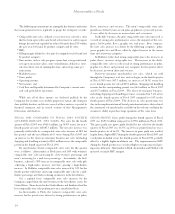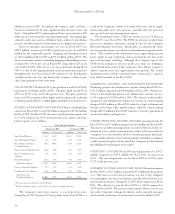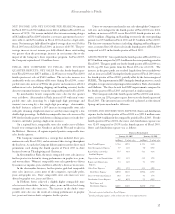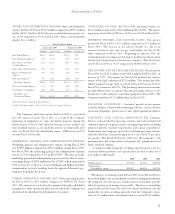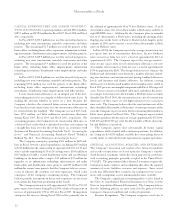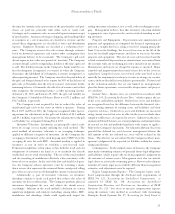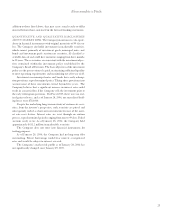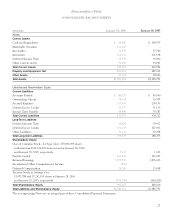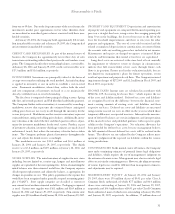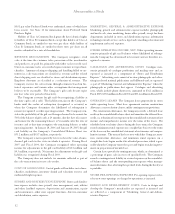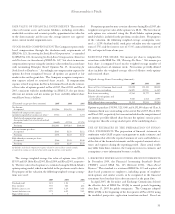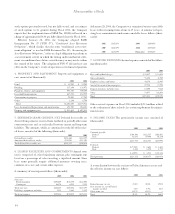Abercrombie & Fitch 2005 Annual Report Download - page 26
Download and view the complete annual report
Please find page 26 of the 2005 Abercrombie & Fitch annual report below. You can navigate through the pages in the report by either clicking on the pages listed below, or by using the keyword search tool below to find specific information within the annual report.
Employees.” Accordingly, no compensation expense for options has
been recognized because all options are granted at fair market value
on the grant date. The Company recognizes compensation expense
related to restricted stock unit awards to associates and non-associ-
ate directors.
For the disclosure requirement of SFAS No. 123, the
Company’s equity compensation expense related to stock options is
estimated using the Black-Scholes option-pricing model to deter-
mine the fair value of the stock option grants, which requires the
Company to estimate the expected term of the stock option grants
and expected future stock price volatility over the term. The
Company uses the vesting period of the stock option as a proxy for
the term of the option. Estimates of expected future stock price
volatility are based on the historic volatility of the Company’s stock
for the period equal to the expected term of the stock option. The
Company calculates the historic volatility as the annualized stan-
dard deviation of the differences in the natural logarithms of the
weekly stock closing price, adjusted for dividends and stock splits.
The fair market value calculation under the Black-Scholes val-
uation model is particularly sensitive to changes in the term and
volatility assumptions. Increases in term or volatility will result in a
higher fair market valuation of stock option grants. Assuming all
other assumptions disclosed in Note 2 of the Notes to Consolidated
Financial Statements, “Summary of Significant Accounting Policies
- Stock Based Compensation,” being equal, a 10% increase in term
will yield a 4% increase in the Black-Scholes valuation, while a 10%
increase in volatility will yield a 8% increase in the Black-Scholes
valuation. The Company believes that changes in term and volatil-
ity will not have a material effect on the Company’s results since the
number of stock options granted during the period was not material.
RECENTLY ISSUED ACCOUNTING PRONOUNCEMENTS
In December 2004, the Financial Accounting Standards Board
(“FASB”) issued SFAS No. 123(R). This standard is a revision of SFAS
No. 123 and requires all share-based payments to employees, includ-
ing grants of employee stock options and similar awards, to be
recognized in the financial statements based on their fair values meas-
ured at the grant date.
In April 2005, the Security And Exchange Commission delayed
the effective date of SFAS No. 123(R) to annual periods beginning
after June 15, 2005 for public companies. Based on stock options
previously issued, but not fully vested, and an estimate of stock
options to be granted during Fiscal 2006, the Company expects that
the implementation of SFAS No. 123(R) will result in a charge of
approximately $0.10 per fully-diluted share for Fiscal 2006.
Effective January 28, 2006, the Company adopted FASB
Interpretation No. 47 (“FIN 47,”) “Conditional Asset Retirement
Obligations,” which clarifies that the term “conditional asset retire-
ment obligation” as used in FASB Statement No. 143, “Accounting
for Asset Retirement Obligations”, refers to a legal obligation to per-
form an asset retirement activity in which the timing and/or method
of settlement are conditional on a future event that may or may not
be within the control of the entity. The adoption of FIN 47 did not
have any effect on the Company’s results of operations or its finan-
cial position.
IMPACT OF INFLATION The Company’s results of operations
and financial condition are presented based upon historical cost.
While it is difficult to accurately measure the impact of inflation due
to the imprecise nature of the estimates required, the Company
believes that the effects of inflation, if any, on its results of operations
and financial condition have been minor.
FORWARD-LOOKING STATEMENTS AND RISK FACTORS
The Company cautions that any forward-looking statements (as such
term is defined in the Private Securities Litigation Reform Act of
1995) contained in this Form 10-K or made by management involve
risks and uncertainties and are subject to change based on various
important factors, many of which may be beyond its control. Words
such as “estimate,” “project,” “plan,” “believe,” “expect,” “antici-
pate,” “intend,” and similar expressions may identify forward-looking
statements. The following factors in some cases have affected and in
the future could affect the Company’s financial performance and
could cause actual results to differ materially from those expressed or
implied in any of the forward-looking statements included in this
report or otherwise made by management:
■changes in consumer spending patterns and consumer pref-
erences;
■the impact of competition and pricing;
■disruptive weather conditions;
■availability and market prices of key raw materials;
■currency and exchange risks and changes in existing or potential
duties, tariffs or quotas;
■availability of suitable store locations on appropriate terms;
■ability to develop new merchandise;
■ability to hire, train and retain associates; and
■the effects of political and economic events and conditions
domestically and in foreign jurisdictions in which the
Company operates, including, but not limited to, acts of terror-
ism or war.
Future economic and industry trends that could potentially
impact net sales and profitability are difficult to predict. Therefore,
there can be no assurance that the forward-looking statements includ-
ed in this report will prove to be accurate and the inclusion of such
information should not be regarded as a representation by the Company,
or any other person, that its objectives will be achieved. Except as may
be required by applicable law, the Company assumes no obligation to
publicly update or revise its forward-looking statements.
Because forward-looking statements involve risks and uncer-
tainties, the Company cautions that there are important factors, in
24
Abercrombie &Fitch


